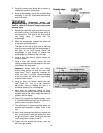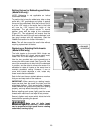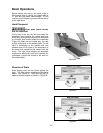
24
Surfacing
The purpose of planing on a jointer is to produce
one flat surface. The other side can then be
milled to precise, final dimensions on a
thickness planer resulting in a board that is
smooth and flat on both sides and each side
parallel to the other.
If the wood to be jointed is cupped or
bowed, place the concave side down, and
take light cuts until the surface is flat.
Use push blocks to help insure against
hands coming in contact with cutterhead in
the event of a kickback.
Never surface pieces shorter than 12 inches
or thinner than 3/8 inch without the use of a
special work holding fixture.
Never surface pieces thinner than 3 inches
without the use of a push block.
On stock longer than 12 inches use two
push blocks (Figure 37).
Figure 37
With narrow stock use the type push block
shown in Figure 38.
When the stock is longer
than twice the length of the infeed and
outfeed tables, another helper or support
table must be used to support the stock.
Figure 38
Jointing
Jointing (or edging) is the process of creating a
finished, flat edge surface that is suitable for
joinery or finishing. It is also a necessary step
prior to ripping stock to width on a table saw.
Never edge a board that is less than 3
inches wide, less than 1/4 inch thick, or 12
inches long, without using a push block.
When edging wood wider than 3 inches, lap
the fingers over the top of the wood,
extending them back over the fence such
that they will act as a stop for the hands in
the event of a kickback.
Position the fence (move forward) to expose
only the amount of cutterhead required.
When workpiece is twice the
length of the jointer infeed or outfeed table
use an infeed or outfeed support.
To edge:
1. Make sure the fence is set to 90°. Double
check it with a square.
2. Inspect stock for soundness and grain
direction (Refer to Direction of Grain on
page 23).
3. If the board is bowed (curved), place the
concave edge down on the infeed table.
4. Set the infeed table for a cut of
approximately 1/16 inch.
5. Hold the stock firmly against the fence and
table, feed the stock slowly and evenly over
the cutterhead.


















